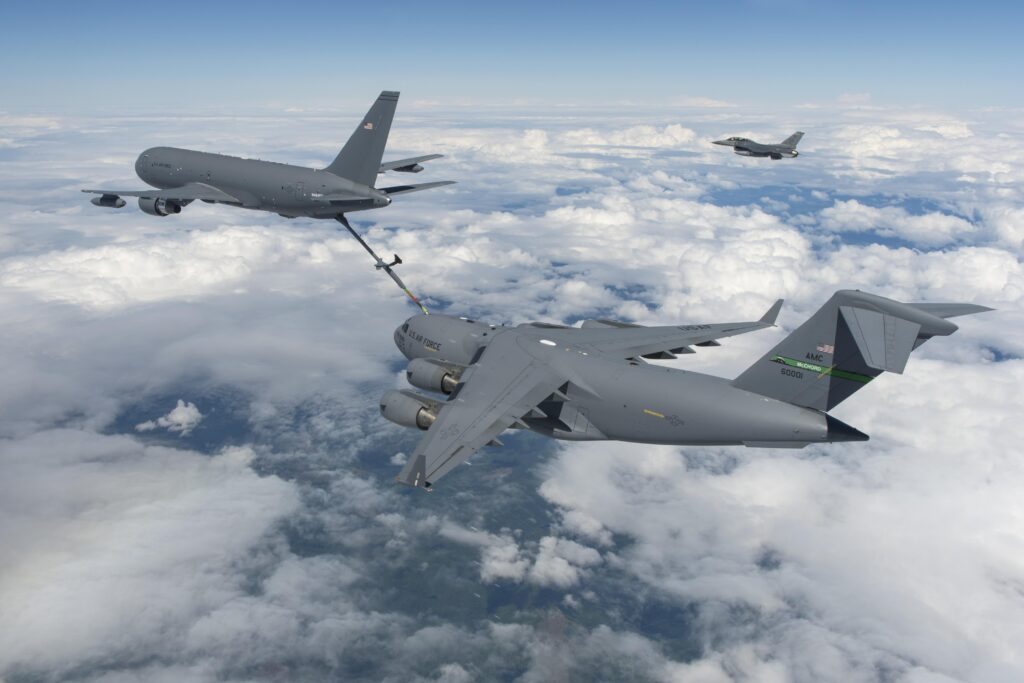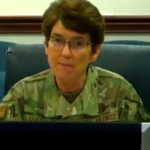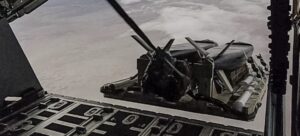
A KC-46 tanker refuels a C-17 transport in mid-air, with an F-16 fighter flying close by.WASHINGTON: In future conflicts, tanker and transport aircraft must be able to drop smart bombs, relay vital tactical data when networks go down and steer clear of long-range anti-aircraft missiles, the new chief of Air Mobility Command said this afternoon. The key to all that, says Gen. Jacqueline Van Ovost, is connectivity.

Gen. Jacqueline Van Ovost speaks to reporters online.
Currently, Van Ovost told reporters at the virtual AFA 2020 conference, her aircrafts’ communications are largely limited to line-of-sight radio networks. Now, radio goes a long way when you’re flying 50,000 feet in the air, but it’s not enough for future warfare, when satellites and smart weapons can hunt targets hidden over the horizon.
So Air Mobility Command is experimenting with beyond-line-of-sight communications, including in the Air Force’s ABMS battle network “on-ramps” and other Joint All-Domain Command & Control (JADC2) experiments:
- In one test, a C-17 cargo jet, long capable of paradropping supplies to frontline troops, dropped a pallet of simulated JASSM missiles. A test with live munitions is planned.
- In another, a C-17 in flight received updates on ground targets and passed that data to a Marine Corps HIMARS rocket launcher in its cargo hold. That allowed the crew to reprogram their missiles to strike the updated locations during the flight, then swiftly set up to fire on arrival.
- In a third, even more ambitious exercise, F-15 fighters cleared a path through simulated air defenses for 35 aircraft – both C-17 jets and the smaller turboprop C-130s – to land at dirt-strip airfields. The 35 transports were receiving “real-time in-flight updates” using a commercially available beyond-line-of-sight communications technology, Van Ovost said, a first for Air Mobility Command.
- As part of the Air Force’s upcoming EdgeONE experiment, the Air Force will turn one of AMC’s aircraft into a flying communications relay and data processing node, providing a backup network connection to joint forces in case other links are jammed or destroyed.
But, I asked, how can large, unstealthy and slow transports and tankers conduct these ambitious missions in a conflict against a high-tech adversary like Russia or China, who can target them with long-range surface-to-air missiles and 4th generation fighters?
Air Mobility Command is looking to upgrade the self-defense systems on its aircraft, Van Ovost answered. But the most important weapon is information – those real-time updates on where the threats are and what air corridors are clear, which can change moment to moment as US forces try to bomb, jam, and hack openings in the enemy’s defensive net.

A CLEAVER 2-pack Pallet is deployed from MC-130J in an AFRL/AFSOC experiment.
“The number one thing we need is that situational awareness and beyond-line-of-sight capability, where we can have in the cockpit an understanding of where that hole is and how long it’s open for and how close we can get to it before we have to think about scramming, turning around and getting out of that location,” Van Ovost said. “Not all tankers and air lifters are going to be at the very forward edge, but the jets that are need that situational awareness.”
In the near term, though, Air Mobility Command’s most pressing concern is the Boeing-built KC-46 Pegasus tanker, built by Boeing, plagued by technical problems. Van Ovost said today she is still withholding a few percent of scheduled progress payments to Boeing until it completely clears up an ongoing problem with forgotten tools and other Foreign Object Debris (FOD) being left aboard the aircraft when they’re delivered – loose objects that could become projectiles during aerial maneuvers, with costly or even fatal results. (The Air Force hasn’t providing an exact dollar figure, though we’re continuing to ask).
The Air Force is also intently reviewing Boeing proposals to fix the Remote Vision System, meant to allow the tanker crew to clearly see the aircraft pulling up behind them and properly align the refueling boom. The company has come up with an interim fix called Enhanced RVS which does give a sharper image, Van Ovost says. But she’s still awaiting evidence that it’s enough to make a difference – and she won’t accept any interim solution that delays Boeing’s progress towards delivering the full solution, called RVS 2.0, by 2023.
In a ‘world first,’ DARPA project demonstrates AI dogfighting in real jet
“The potential for machine learning in aviation, whether military or civil, is enormous,” said Air Force Col. James Valpiani. “And these fundamental questions of how do we do it, how do we do it safely, how do we train them, are the questions that we are trying to get after.”


























